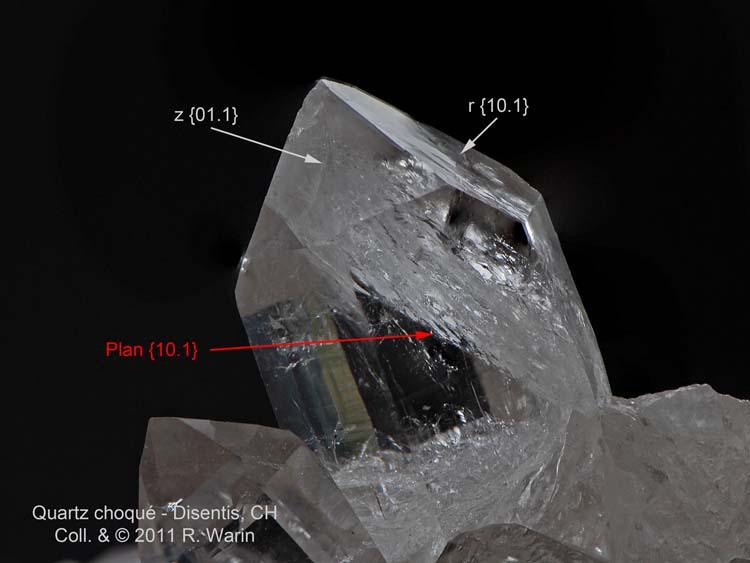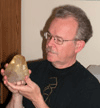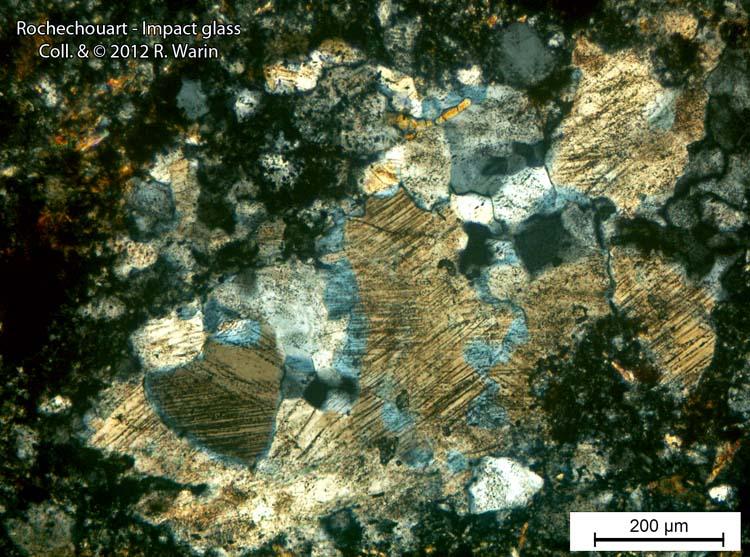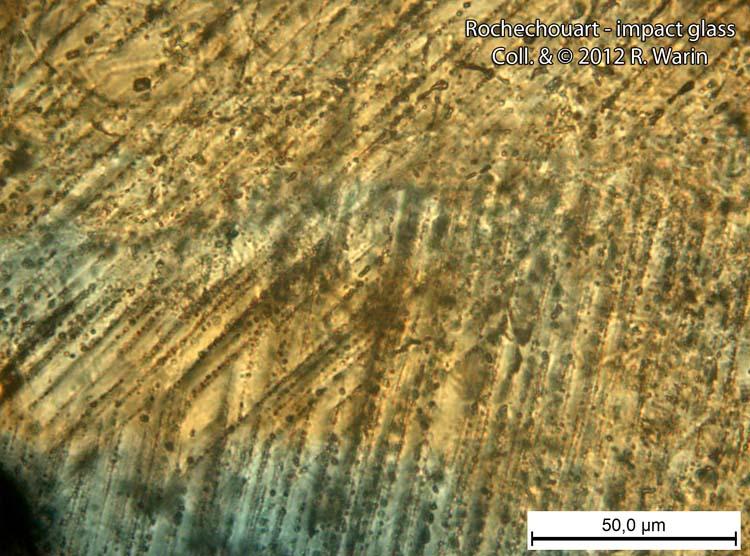| View previous topic :: View next topic |
| Author |
Message |
Roger Warin

Joined: 23 Jan 2013
Posts: 1246



|
 Posted: Sep 17, 2013 15:57 Post subject: Shocked quartz, what is it? Posted: Sep 17, 2013 15:57 Post subject: Shocked quartz, what is it? |
|
|
Hi List,
The notion of shocked quartz cannot be understood as it should be because words sometimes hide concepts.
A shocked quartz is not a crushed rock agglomerated into a breccia. Under high pressures (but limited temperatures) and without destroying their morphology, crystal quartz undergoes a first deformation along the plane (r) (10.1).
This typically occurs in alpine quartz, as shown by my pic of a Disentis quartz.
This quartz crystal then has a fake cleavage along (r), while others remain conchoidal fractures.
But the real shocked quartz are found in impactites, these rocks being impacted by a large meteorite. That is another story.
Roger.
| Description: |
Shocked quartz
Disentis, CH
with a false cleavage induced by shock. |
|
| Viewed: |
20663 Time(s) |

|
|
|
| Back to top |
|
 |
Pete Richards
Site Admin

Joined: 29 Dec 2008
Posts: 846
Location: Northeast Ohio



|
 Posted: Sep 17, 2013 16:11 Post subject: Re: Shocked quartz, what is it? Posted: Sep 17, 2013 16:11 Post subject: Re: Shocked quartz, what is it? |
|
|
| Roger Warin wrote: | Hi List,
The notion of shocked quartz cannot be understood as it should be because words sometimes hide concepts.
A shocked quartz is not a crushed rock agglomerated into a breccia. Under high pressures (but limited temperatures) and without destroying their morphology, crystal quartz undergoes a first deformation along the plane (r) (10.1).
This typically occurs in alpine quartz, as shown by my pic of a Disentis quartz.
This quartz crystal then has a fake cleavage along (r), while others remain conchoidal fractures.
But the real shocked quartz are found in impactites, these rocks being impacted by a large meteorite. That is another story.
Roger. |
Yes, I agree that these are very different things. I believe quartz is considered to have a poor cleavage along {10.1}, and this is often manifested in alpine veins and pegmatites, where quartz gets broken along these planes, either completely or partially (a crack), and often healed by later growth. This stress is applied fairly to very gradually, whereas in true shocked quartz the stress is applied virtually instantaneously. I would refer to the first case as stress-fractured rather than shocked, but semantics are semantics....
_________________
Collecting and studying crystals with interesting habits, twinning, and epitaxy |
|
| Back to top |
|
 |
Bob Carnein
Joined: 22 Aug 2013
Posts: 359
Location: Florissant, CO



|
 Posted: Sep 17, 2013 18:40 Post subject: Re: Shocked quartz, what is it? Posted: Sep 17, 2013 18:40 Post subject: Re: Shocked quartz, what is it? |
|
|
| True "shocked quartz" can be confused with quartz that has undergone metamorphic deformation (Boehm lamellae), and both kinds of features can occur together. Some workers have confused the two. I'd recommend the following article: J.S. Alexopoulos, et. al., 1988, Microscopic lamellar deformation features in quartz: discriminative characteristics of shock-generated varieties: Geology, vol. 16, no. 9, p. 796-799.
|
|
| Back to top |
|
 |
Roger Warin

Joined: 23 Jan 2013
Posts: 1246



|
 Posted: Sep 18, 2013 15:26 Post subject: Re: Shocked quartz, what is it? Posted: Sep 18, 2013 15:26 Post subject: Re: Shocked quartz, what is it? |
|
|
Hi List,
Impactites are rocks that have been the target of a large meteorite.
Intense shock obviously disrupts the crystal lattice of mineral grains. When the pressure reaches a field of 5-35 Gigapascals (350000 bars or atm), it may appear in the quartz grains of impactites some "Planar Deformation Features" or PDF's.
PDF's are in fact planar deformation (or acicular grouped in a plane) that appear on many lattice planes. PDF’s aren’t fractures. They are composed of amorphous materials and they can be “decorated”, with bubbles of fluid inclusions.
The least attached plans of their parallel neighbors suffer deformation in the first place. Many other plans (characterized by their different orientation in the crystal) as the most preferred {10.1} are also affected. They were well observed on {01.1} {10.0} {00.1} {11.0} {11.1} {51.1}, etc.. This often gives the appearance of parallel lines that cross the thin blade. These crosses lines are also an identification of PDF's argument, distinguishing polysynthetic twins (repeated multiple times in feldspar or pyroxene).
These rocks are actually the real shocked quartz, a name imposed by scientists studying impact craters.
Roger.
| Description: |
Impactite with quartz grains
Rochechouart impact crater
Thin section XPol light |
|
| Viewed: |
19893 Time(s) |

|
| Description: |
Quartz - PDF's
Rochechouart impact crater
630 X |
|
| Viewed: |
19997 Time(s) |

|
|
|
| Back to top |
|
 |
|





